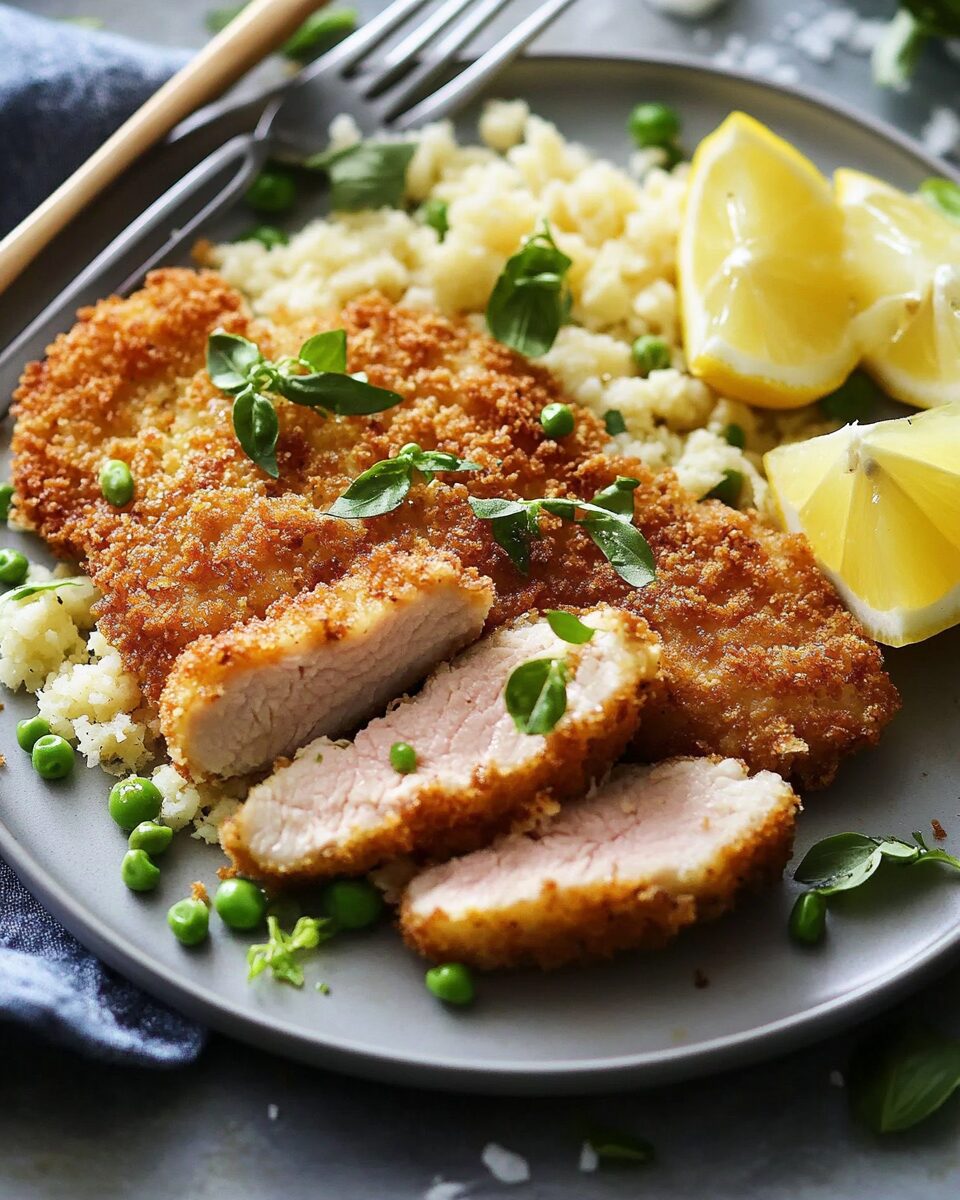This Pork Schnitzel recipe is a simple and satisfying dinner for two, featuring crispy, golden-brown cutlets made from tenderized pork tenderloin. A staple in Central European kitchens, schnitzel delivers the perfect crunch without being greasy—when fried properly. This version is small-batch, quick to prepare, and an ideal comfort meal for weeknights or a cozy weekend supper, especially when paired with German potato salad, sauerkraut, or mashed potatoes.
Full Recipe:
Ingredients
-
1 small pork tenderloin (less than 1 pound)
-
Salt, to taste
-
Pepper, to taste
-
1 cup white Panko bread crumbs
-
2 large eggs
-
2 cups + 1 tablespoon vegetable oil (preferably peanut or canola)
-
Lemon wedges, for serving
Directions
Step 1: Prepare the Pork
Place the pork tenderloin on a clean cutting board and slice it in half at a 45-degree angle. Cover each piece with plastic wrap and pound flat using a meat mallet or rolling pin until ¼-inch thick.
Step 2: Season and Bread
Generously salt and pepper each cutlet. In one shallow dish, place the Panko. In another, whisk together the eggs and 1 tablespoon oil. Dip each cutlet into the egg mixture, then coat in Panko, pressing firmly so the crumbs adhere well.
Step 3: Heat the Oil
Pour 2 cups of oil into a small Dutch oven and heat it over medium heat to 375°F. Test the temperature by dropping in a few crumbs—they should sizzle and float.
Step 4: Fry the Schnitzel
Carefully add the breaded cutlets to the hot oil. Fry for 1–2 minutes per side until golden brown and crisp. Remove and drain on paper towels.
Step 5: Serve
Let the schnitzel cool slightly before serving with lemon wedges on the side.
Nutrients (Per Serving, Approximate)
-
Calories: 419 kcal
-
Total Fat: 16g
-
Saturated Fat: 3g
-
Trans Fat: 0g
-
Unsaturated Fat: 11g
-
Cholesterol: 217mg
-
Sodium: 782mg
-
Carbohydrates: 43g
-
Fiber: 4g
-
Sugar: 4g
-
Protein: 25g
The Charm of Schnitzel
Schnitzel, in all its forms, is about transforming a modest piece of meat into something extraordinary. The hallmark of a great schnitzel lies in its texture—thin, tender meat enveloped in a light, golden crust that crackles with each bite. What makes this dish special is the contrast between the juicy pork and the crisp breadcrumb coating. While the technique is simple, mastering it ensures restaurant-quality results at home. Its appeal spans generations and borders, with versions found in Germany, Austria, Poland, and even Israel.
Cultural Significance
Though many associate schnitzel with Germany, its true origin lies in Austria, where Wiener Schnitzel is a national treasure. The term “schnitzel” simply refers to a breaded and fried meat cutlet, and various countries have adopted their own interpretations. In Germany, pork schnitzel is especially popular, often topped with sauces like jägersoße (mushroom sauce) or zigeunersoße (bell pepper sauce). In Hungary and Czech Republic, schnitzel is commonly served with potato salads or cabbage slaws. This pan-European comfort food has now become a global favorite, recognized for its crispy texture and timeless flavor.
Why You’ll Love This Recipe
This pork schnitzel recipe is tailor-made for busy weeknights or low-key weekend dinners. It requires minimal ingredients, yet delivers maximum flavor. The pork tenderloin cooks quickly, and the breading process is straightforward, especially when using panko breadcrumbs, which offer an extra-crunchy texture. The result is a deeply satisfying dish that feels indulgent without being heavy. Plus, this recipe serves two, making it ideal for couples, roommates, or anyone cooking for themselves and one lucky guest. No waste, no fuss—just the right amount of comfort.
Flavor Profile and Texture
What sets schnitzel apart is its irresistible crunch paired with the delicate, juicy texture of tenderized pork. The seasoning is simple—salt and pepper—but the breading seals in moisture and adds depth through its crisp texture. Served with a wedge of lemon, the acid brightens up each bite, cutting through the richness of the fried coating. When done properly, schnitzel is never greasy; instead, it’s light, airy, and deeply savory.
Serving Suggestions
Classic accompaniments for pork schnitzel include German potato salad with vinegar and bacon, creamy mashed potatoes, sauerkraut, or a refreshing cucumber salad. For a lighter meal, serve it alongside mixed greens with a tangy mustard vinaigrette. A dollop of lingonberry jam or a drizzle of Dijon mustard also pairs beautifully with schnitzel, adding sweetness or bite to complement the crispy coating. And of course, don’t forget the lemon wedges—they’re essential.
Health Benefits
While schnitzel may not be a typical “health food,” this pork version offers a few redeeming qualities. Pork tenderloin is a lean cut of meat, lower in fat and calories compared to many other pork cuts. It’s also an excellent source of protein, B vitamins (especially B6 and B12), zinc, and selenium. Using panko breadcrumbs allows for a crisp coating with less oil absorption, especially when the schnitzel is fried at the correct temperature. When paired with nutrient-dense sides like red cabbage, steamed greens, or roasted vegetables, schnitzel can be part of a balanced meal.
Common Mistakes to Avoid
Overcrowding the pan is one of the biggest mistakes when frying schnitzel. This causes the temperature of the oil to drop, resulting in soggy rather than crisp cutlets. Always fry in batches if needed and maintain a steady oil temperature of 375°F. Another common error is using too much or too little oil—shallow frying works best, with enough oil to submerge the cutlet halfway. Skipping the step of pounding the meat thin can also lead to uneven cooking and tough texture. And lastly, do not skip the resting period after frying; letting schnitzel rest on paper towels helps it retain its crunch without becoming greasy.
Perfect Pairings
Pork schnitzel pairs well with both wine and beer. A crisp white wine like Grüner Veltliner, dry Riesling, or Pinot Grigio works beautifully. For beer lovers, go for a pilsner or Helles lager to match the dish’s light crispiness. Side dish pairings should offer a balance of texture and acidity. A creamy potato mash or vinegary cabbage slaw complements the richness of the fried pork. Add a pop of color and nutrition with roasted carrots or sautéed green beans.
Ingredient Spotlight: Pork Tenderloin
Pork tenderloin is the ideal cut for schnitzel—it’s lean, tender, and cooks quickly. When pounded thin, it remains juicy while achieving a delicate bite. Unlike pork chops or shoulder, tenderloin requires minimal trimming and has a mild flavor that absorbs seasoning well. It’s also more forgiving than veal or chicken when frying, making it a great option for beginners. Choosing a tenderloin under 1 pound ensures manageable portions for two people, with no leftovers.
Why This Recipe Stands Out
What makes this recipe shine is its balance between tradition and convenience. It uses classic techniques—tenderizing, breading, and frying—but scales them down for modern cooks preparing meals for one or two. The use of panko adds a contemporary twist, delivering exceptional crunch. The result is an authentic pork schnitzel that feels special yet fits seamlessly into busy lifestyles. It’s an approachable version of a classic that doesn’t compromise on flavor or texture.
Variations to Try
Once you master the basic pork schnitzel, there are many ways to experiment. Add finely grated Parmesan to the breadcrumb mixture for a cheesy crust. Infuse the egg mixture with a touch of Dijon mustard or hot sauce for added kick. For an herby touch, mix dried oregano or thyme into the breadcrumbs. Want a gluten-free version? Swap panko for crushed rice cereal or gluten-free breadcrumbs. You can also transform the schnitzel into a sandwich by layering it onto a crusty roll with slaw and mustard mayo.
Conclusion
Pork Schnitzel is more than just a fried cutlet—it’s a dish steeped in culinary tradition and transformed for the modern kitchen. Crisp, juicy, and endlessly satisfying, it’s the kind of recipe that turns a regular evening into a memorable meal. With just a handful of ingredients and a bit of frying finesse, you can bring the warmth and flavor of Central Europe to your own table. Whether you serve it with creamy mash, tangy sauerkraut, or a light salad, this schnitzel is sure to become a repeat favorite in your dinner rotation. It’s proof that the best meals are often the simplest—especially when they’re made with care.

